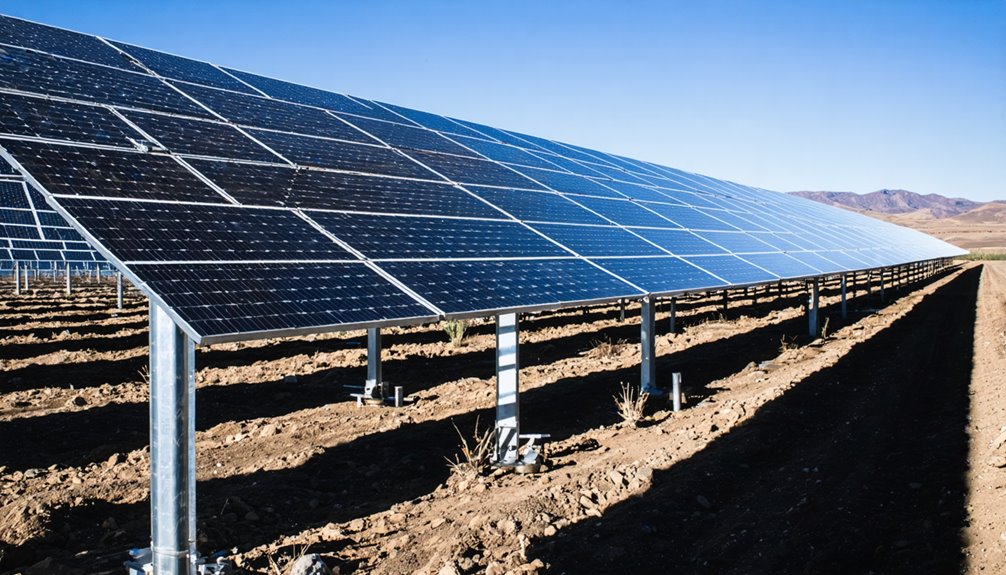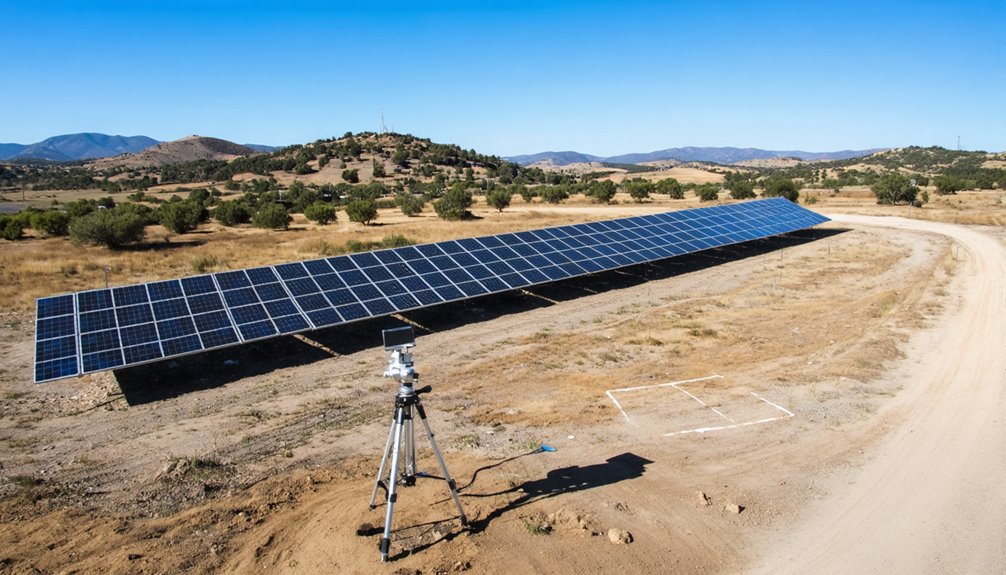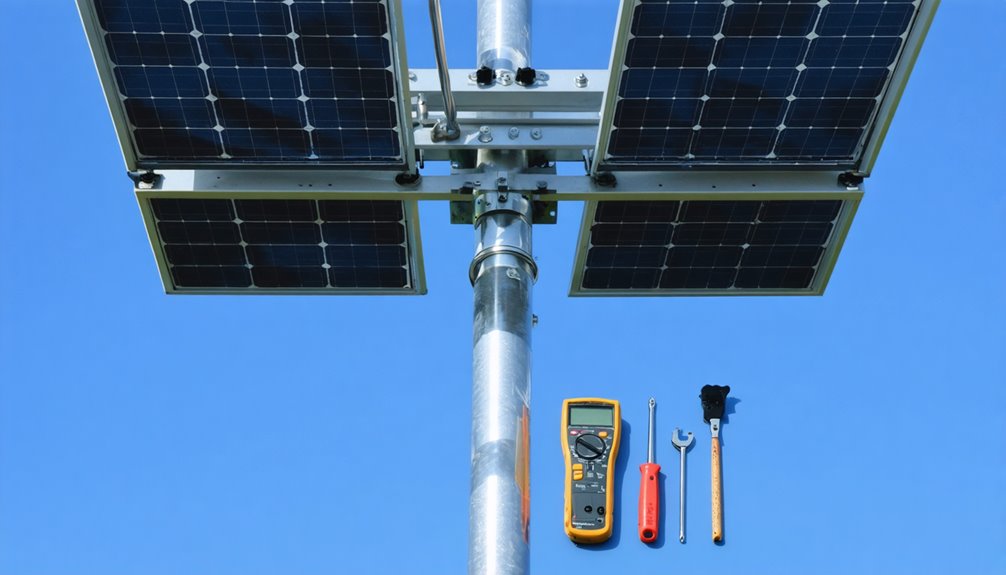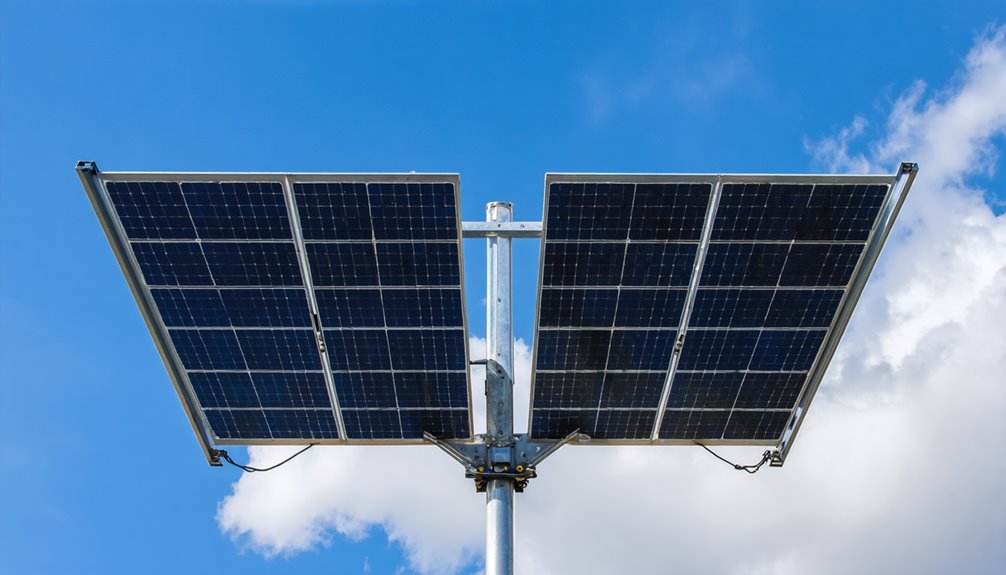You’re seeing more pole-mounted solar panels in neighborhoods and rural areas across the country. These systems sit high above ground on sturdy poles, capturing sunlight better than traditional rooftop installations. Property owners are choosing them for various reasons – from avoiding roof damage to maximizing energy production. But there’s more to these elevated power generators than meets the eye, including specific requirements that might surprise you.
Understanding Pole Mount Solar Systems and Their Applications

When you’re looking at solar power options, pole mount systems offer a unique solution that’s different from typical rooftop installations. These pole mount installations raise your solar panel system high above ground level. They’re designed to catch more sunlight by avoiding shadows from buildings and trees.
Unlike ground-mounted solar arrays that need multiple foundation points, pole mounts require just one concrete base for stability. You can install 12 to 24 solar modules on a single pole. Some systems let you make manual adjustment to the panel angles, which boosts energy production throughout the year.
These systems work well for off-grid solar projects. They’re also perfect when you don’t have enough roof space. The elevated design fits into your existing landscape without taking up much ground area. When comparing mounting system options, pole mounts often provide superior adjustability and energy efficiency compared to fixed installations.
Benefits of Choosing Pole-Mounted Solar Installations
Pole mount systems offer several advantages that make them stand out from other solar installation options. You’ll find these solar energy installations take up less space than ground-mounted systems. They’re perfect when you don’t have much room on your property.
The adjustable angles on pole mounts let you change the tilt throughout the year. This means you’ll capture more sunlight as seasons change. Enhanced performance is another big plus. Some systems can boost energy output by 25% when they use solar trackers. Advanced pole mounts equipped with tracking mechanisms automatically follow the sun’s path throughout the day, potentially increasing power generation by up to 25-40%.
Simplified maintenance makes these systems practical too. You can easily clean the panels and remove snow since they’re raised off the ground. The stability of pole mounts comes from their strong foundations, which don’t need as much digging as other setups.
Types of Solar Panel Pole Mounting Configurations
Two main types of pole mounting configurations exist for solar panels. You’ll find top of the pole mounts and side of the pole options available.
Top of the pole systems can hold up to 24 modules. Most installations use about 12 panels. These pole mounts let you adjust the tilt manually. They need 2 to 8-inch Schedule 40 or 80 pipes.
Side of the pole configurations work best for smaller systems. They’re perfect for powering lights or refrigerators. These require 2 to 4.5-inch Schedule 40 or 80 pipes.
Both solar panel mounting types have a small installation footprint. They only need one concrete foundation. Manufacturers can customize these systems for tough environmental conditions like high winds. These mounting systems undergo rigorous wind and snow load testing to ensure structural integrity and reliability in extreme weather conditions.
Planning and Site Evaluation for Pole Mount Systems

When you’re planning a pole mount solar system, you’ll need to check several important factors at your site first. You can use tools like the Sun Seeker app to see if trees or buildings will block sunlight from reaching your panels. Your installer will also need to dig the pole at least one-third of its total length underground to keep it stable in wind and weather. Unlike ground mount systems that distribute weight across multiple foundations, pole mounts require careful structural engineering to ensure the single support point can withstand all environmental loads.
Site Assessment Best Practices
Evaluating your property thoroughly before installing a solar pole mount system can make the difference between success and costly mistakes. You’ll need to check several key factors during your site assessment.
Solar mounting systems work best when they’re placed in spots with maximum sun exposure. You should examine how trees and buildings create shading throughout the day. Apps like Sun Seeker help track shadow patterns that affect solar panel efficiency.
Your energy needs determine the size of pole mounts you’ll require. Local regulations also shape what you can build and where. You’ll want to test soil stability and measure wind conditions too. These factors influence which materials work best.
Don’t forget to map out trenching paths and conduit lengths. These underground connections affect your total costs considerably.
Shading Analysis Tools
Shading analysis tools have become standard equipment for solar installers who need to predict how shadows will affect panel performance. You’ll find professionals using apps like Sun Seeker to check solar panel placement on pole mounts before installation begins. These digital tools map the sun’s path throughout the year. They show where shadows from trees or buildings might reduce sunlight exposure.
Shadow analysis helps installers create accurate energy production estimates. Here’s what modern tools can measure:
| Analysis Feature | What It Shows | Why It Matters |
|---|---|---|
| Sun Path Tracking | Daily sun movement | Identifies peak hours |
| Obstruction Mapping | Shadow sources | Prevents placement errors |
| Seasonal Changes | Year-round patterns | Guarantees peak efficiency |
Smart planning with these tools means pole-mounted systems produce maximum power throughout their lifetime.
Foundation Depth Requirements
While solar panels need solid support, their pole foundations must go deep enough to handle wind and weight loads. Most pole mount systems follow a simple rule: one-third of the pole goes underground and two-thirds stays above ground. This ratio helps maintain stability.
You’ll typically need a foundation depth of 3-4 feet for standard installation. However, soil conditions change these requirements. Sandy soils often need deeper holes than clay or rocky ground. Your area’s frost depth also matters. In cold regions, foundations must go below the frost line to prevent ground movement.
Local building codes set specific rules for your location. They’ll tell you exact depth requirements based on typical wind speeds and ground conditions. Always check these codes before starting any solar project.
Foundation Requirements and Pole Installation Process
Creating a stable foundation involves digging deep enough to support your solar panel pole mount system. Installers follow the one-third underground and two-thirds above-ground depth rule for pole mounts. They’ll need concrete specifications that include Schedule 40 or Schedule 80 pipes ranging from two to eight inches.
Before solar panel installation begins, workers clear the site preparation area. They check soil composition and drainage patterns. This prevents future erosion problems.
During installation, crews use bracing techniques with 2×4 or 2×6 boards. These temporary supports hold poles straight while concrete hardens.
Most areas require local compliance with building codes. These regulations determine foundation depth requirements. Inspectors verify that pole installations meet safety standards. Each location has different rules for mounting solar equipment.
Electrical Components and Wiring Considerations
You’ll need to connect your solar panels to a grounding system that meets local electrical codes to prevent electrical shocks and equipment damage. Your inverter connects to the solar panels through DC wiring and then converts that power to AC electricity for your home’s use. Most installations require a grounding rod that’s at least 8 feet long and copper wiring that creates a safe path for electrical faults. When selecting an inverter for your pole mount system, consider models with high efficiency ratings above 95% to maximize your solar energy conversion and reduce power losses during operation.
Grounding Requirements
When installing solar panel pole mount systems, grounding requirements play a critical role in protecting against electrical surges and ensuring safety. You’ll need to connect ground wires to a grounding rod at the pole’s base. The National Electrical Code provides guidelines for wire sizes and methods. Copper wire’s typically used because it conducts well and resists corrosion.
Bonding connections link solar panel frames, mounts, and the grounding system. These prevent dangerous voltage differences. You’ll need regular inspections to check for corrosion and loose connections. In areas with high lightning activity or conductive soil, enhanced measures work better. Multiple grounding rods or mesh systems improve your solar pole mount system’s resilience against electrical damage.
Inverter Connection Methods
Proper grounding connects to another important electrical component—the inverter. Inverter connection methods for solar pole mount systems offer different choices for homeowners. You’ll find string inverters and microinverters available for various system sizes.
DC to AC inverters convert the panels’ direct current into alternating current. This conversion lets you power household appliances and connect to the grid. Your system’s wiring considerations include choosing cables that match voltage and current needs. Properly sized cables prevent overheating and guarantee efficient energy transfer.
Local electrical codes dictate installation standards. These regulations cover grounding requirements and other safety measures. Cable management protects your wiring from weather and physical damage. Protected cables last longer and maintain system reliability. Each connection method has specific advantages depending on your setup’s design preferences.
Mounting Hardware and Solar Panel Attachment Methods
While mounting hardware may seem like just nuts and bolts, these components are what keep your solar panels secure on their poles for decades. Your pole mounts use rails, brackets, and mounting clamps to create stable solar panel attachment methods. Top pole mounts can support up to 24 solar modules, though they typically hold about 12 panels. These systems feature adjustable tilt angles that boost efficiency.
Side pole mounts work for smaller setups. They’ll need a 2 to 4.5 inch Schedule 40 or 80 pipe. The mounting clamps grip panels to rails with minimal friction. Top pole mounts have a compact installation footprint. They only need one concrete foundation, unlike ground mounts that require more space. The brackets’ material durability plays a crucial role in withstanding harsh weather conditions and ensuring your solar investment remains protected for years to come.
Maintenance and Performance Optimization Strategies

Your pole-mounted solar system needs regular check-ups to keep producing maximum power. Dirt and debris block sunlight, cutting your panels’ performance. You’ll want to inspect pole mounts for rust that weakens structural integrity.
Annual checks of electrical connections prevent energy losses. Loose wires reduce output and create safety hazards. You’re looking at significant risks without proper maintenance.
Seasonal tilt angle adjustments boost solar exposure dramatically. Different angles increase energy capture by up to 25%, depending on your location. You’ll see better performance when panels match the sun’s path.
Unlike non-penetrating mounting solutions that sit on flat roofs, pole mounts require checking underground footings and above-ground connections for stability.
You need clear access around your system for snow removal and trimming plants. These maintenance tasks directly impact performance. Regular upkeep guarantees your investment continues delivering clean energy year-round.
Conclusion
You’ve learned that pole mount solar systems offer flexible solutions for capturing sunlight. These installations work well in areas with limited space and off-grid locations. They’re adjustable for different seasons and weather conditions. Regular maintenance keeps them running efficiently. With proper planning and the right equipment, pole-mounted systems can provide reliable solar power year-round. They’ve become a practical choice for homeowners and businesses looking to harness solar energy effectively.


